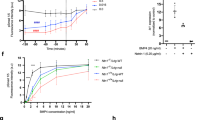Abstract
Bone morphogenetic signaling (BMP) is a key pathway during neurogenesis and depends on many downstream intermediators to carry out its signaling. One such signaling pathway utilizes neurotrophin receptor-interacting MAGE protein (NRAGE), a member of the melanoma-associated antigen (MAGE) family, to upregulate p38 mitogen activated protein kinase (p38MAPK) in response to cellular stress and activate caspases which are critical in leading cells to death. NRAGE consists of two conserved MAGE homology domains separated by a unique hexapeptide repeat domain. Although we have previously implicated NRAGE in inducing apoptosis in neural progenitors and P19 cells, a model system for neural progenitors, its domains have yet to be explored in determining which one may be responsible for setting up the signaling for apoptosis. Here, we overexpressed a series of deletion mutations in P19 cells to show that only those with at least half of the repeat domain, activated p38MAPK and underwent apoptosis offering intriguing incite into NRAGE’s contribution in BMP apoptotic signaling.



Similar content being viewed by others
References
Salehi AH, Roux PP, Kubu CJ et al (2000) NRAGE, A Novel MAGE Protein, Interacts with the p75 neurotrophin receptor and facilitates nerve growth factor dependent apoptosis. Neuron 27:279–288
Pold M, Zhou J, Chen GL, Hall JM, Vescio RA, Berenson JR (1999) Identification of a new, unorthodox member of the MAGE gene family. Genomics 59:161–167
Masuda Y, Sasaki A, Shibuya H, Ueno N, Ikeda K, Watanabe K (2001) Dlxin-1, a novel protein that binds Dlx5 and regulates its transcriptional function. J Biol Chem 276:5331–5338
Xiao J, Chen HS (2004) Biological functions of melanoma-associated antigens. World J Gastroenterol 10:1849–1853
Boon T, Cerottini JC, Van den Eynde B, van der Bruggen P, Van Pel A (1994) Tumor antigens recognized by T lymphocytes. Annu Rev Immunol 12:337–365
Chu C, Xue B, Tu C et al (2007) NRAGE suppresses metastasis of melanoma and pancreatic cancer in vitro and in vivo. Cancer Lett 250:268–275
Wen C, Xue B, Qin W et al (2004) hNRAGE, a human neurotrophin receptor interacting MAGE homologue, regulates p53 transcriptional activity and inhibits cell proliferation. FEBS Lett 564:171–176
Salehi AH, Morris SJ, Ho WC et al (2006) AEG3482 is an antiapoptotic compound that inhibits Jun kinase activity and cell death through induced expression of heat shock protein 70. Chem Biol 13:213–223
Salehi AH, Xanthoudakis S, Barker PA (2002) NRAGE, a p75 neurotrophin receptor-interacting protein, induces caspase activation and cell death through a JNK-dependent mitochondrial pathway. J Biol Chem 277:48043–48050
Kendall SE, Battelli C, Irwin S et al (2005) NRAGE mediates p38 activation and neural progenitor apoptosis via the bone morphogenetic protein signaling cascade. Mol Cell Biol 26:7711–7724
Kendall SE, Goldhawk DE, Kubu C, Barker PA, Verdi JM (2002) Expression analysis of a novel p75NTR signaling protein, which regulates cell cycle progression and apoptosis. Mech Dev 117:187–200
Nakano I, Saiqusa K, Kornblum HI (2008) BMPing off glioma stem cells. Cancer Cell 13:3–4
Nikopoulos GN, Martins JF, Adams TL et al (2009) NRAGE: a potential rheostat during branching morphogenesis. Mech Dev 126:337–349
Jordan BWM, Dinev D, LeMellay V et al (2001) Neurotrophin receptor-interacting mage homologue is an inducible inhibitor of apoptosis protein-interacting protein that augments cell death. J Biol Chem 276:39985–39989
Barker PA, Salehi A (2002) The MAGE proteins: emerging roles in cell cycle progression, apoptosis, and neurogenetic disease. J Neurosci Res 67:705–712
McBurney MW (1993) P19 embryonal carcinoma cells. Int J Dev Biol 37:135–140
Tahara K, Mori M, Sadanaga N, Sakamoto Y, Kitano S, Makuuchi M (1999) Expression of the MAGE gene family in human hepatocellular carcinoma. Cancer 85:1234–1240
Fernandes-Alnemri T, Litwack G, Alnemri ES (1994) CPP32, a novel human apoptotic protein with homology to Caenorhabditis elegans cell death protein Ced-3 and mammalian interleukin-1 beta-converting enzyme. J Biol Chem 269:30761–30764
Deveraux QL, Roy N, Stennicke HR et al (1998) IAPs block apoptotic events induced by caspase-8 and cytochrome c by direct inhibition of distinct caspases. EMBO J 17:2215–2223
Deveraux QL, Takahashi R, Salvesen GS, Reed JC (1997) X-linked IAP is a direct inhibitor of cell-death proteases. Nature 388:300–304
Kaminska B, Wesolowska A, Danilkiewicz M (2005) TGF beta signalling and its role in tumour pathogenesis. Acta Biochim Pol 52:329–337
Kimura N, Matsuo R, Shibuya H, Nakashima K, Taga T (2000) BMP2-induced apoptosis is mediated by activation of the TAK1-p38 kinase pathway that is negatively regulated by Smad6. J Biol Chem 275:17647–17652
Kozak M (1984) Selection of initiation sites by eucaryotic ribosomes: effect of inserting AUG triplets upstream from the coding sequence for preproinsulin. Nucleic Acids Res 12:3873–3893
Kozak M (1984) Compilation and analysis of sequences upstream from the translational start site in eukaryotic mRNAs. Nucleic Acids Res 12:857–872
Acknowledgments
This work was supported by National Institutes of Health (NIH) grant R01NS055304 awarded to JMV and NIH Center of Biomedical Research Excellence (COBRE) P20RR018789 in Stem Cell Biology and Regenerative Medicine to Maine Medical Center (Portland, Maine). J.A.R. was funded by the Integrative Graduate Education Research Training (IGERT) Functional Genomics Ph.D. program through a fellowship from National Science Foundation grant 0221625 awarded to the University of Maine (Orono, Maine), Maine Medical Center Research Institute (Scarborough, Maine), and the Jackson Laboratory (Bar Harbor, Maine).
Author information
Authors and Affiliations
Corresponding author
Rights and permissions
About this article
Cite this article
Rochira, J.A., Cowling, R.A., Himmelfarb, J.S. et al. Mapping of NRAGE domains reveals clues to cell viability in BMP signaling. Apoptosis 15, 63–70 (2010). https://doi.org/10.1007/s10495-009-0427-6
Published:
Issue Date:
DOI: https://doi.org/10.1007/s10495-009-0427-6




